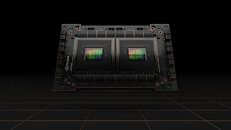- Joined
- Aug 19, 2017
- Messages
- 3,267 (1.13/day)
NVIDIA has today announced its Grace CPU Superchip, a monstrous design focused on heavy HPC and AI processing workloads. Previously, team green has teased an in-house developed CPU that is supposed to go into servers and create an entirely new segment for the company. Today, we got a more detailed look at the plan with the Grace CPU Superchip. The Superchip package represents a package of two Grace processors, each containing 72 cores. These cores are based on Arm v9 in structure set architecture iteration and two CPUs total for 144 cores in the Superchip module. These cores are surrounded by a now unknown amount of LPDDR5x with ECC memory, running at 1 TB/s total bandwidth.
NVIDIA Grace CPU Superchip uses the NVLink-C2C cache coherent interconnect, which delivers 900 GB/s bandwidth, seven times more than the PCIe 5.0 protocol. The company targets two-fold performance per Watt improvement over today's CPUs and wants to bring efficiency and performance together. We have some preliminary benchmark information provided by NVIDIA. In the SPECrate2017_int_base integer benchmark, the Grace CPU Superchip scores over 740 points, which is just the simulation for now. This means that the performance target is not finalized yet, teasing a higher number in the future. The company expects to ship the Grace CPU Superchip in the first half of 2023, with an already supported ecosystem of software, including NVIDIA RTX, HPC, NVIDIA AI, and NVIDIA Omniverse software stacks and platforms.

View at TechPowerUp Main Site
NVIDIA Grace CPU Superchip uses the NVLink-C2C cache coherent interconnect, which delivers 900 GB/s bandwidth, seven times more than the PCIe 5.0 protocol. The company targets two-fold performance per Watt improvement over today's CPUs and wants to bring efficiency and performance together. We have some preliminary benchmark information provided by NVIDIA. In the SPECrate2017_int_base integer benchmark, the Grace CPU Superchip scores over 740 points, which is just the simulation for now. This means that the performance target is not finalized yet, teasing a higher number in the future. The company expects to ship the Grace CPU Superchip in the first half of 2023, with an already supported ecosystem of software, including NVIDIA RTX, HPC, NVIDIA AI, and NVIDIA Omniverse software stacks and platforms.

View at TechPowerUp Main Site








 What you're describing as 'not ideal' is the whole problem of hypercapitalism and the reason why we have regulators and parties that can block such mergers. The actual fact is, consolidation like that has already gone on for far too long and competition is dying because of it, (multinational) corporations have gained power over governments and with that, our entire society and system of democracy suffers. Microsoft is already under a magnifying glass wrt what they do in and with Windows, precisely because they have such a major market influence that nobody can realistically compete with. It is because of this that they can push their cloud ahead of everyone else - not because its the best software solution or service, but because whole generations have grown up knowing the company and its OS. An idea that has absolutely nothing to do with 'free markets' and 'fair competition'. Similar things apply to Intel that can push arguably worse product out and still come out winning YoY - this is actually happening right now.
What you're describing as 'not ideal' is the whole problem of hypercapitalism and the reason why we have regulators and parties that can block such mergers. The actual fact is, consolidation like that has already gone on for far too long and competition is dying because of it, (multinational) corporations have gained power over governments and with that, our entire society and system of democracy suffers. Microsoft is already under a magnifying glass wrt what they do in and with Windows, precisely because they have such a major market influence that nobody can realistically compete with. It is because of this that they can push their cloud ahead of everyone else - not because its the best software solution or service, but because whole generations have grown up knowing the company and its OS. An idea that has absolutely nothing to do with 'free markets' and 'fair competition'. Similar things apply to Intel that can push arguably worse product out and still come out winning YoY - this is actually happening right now.